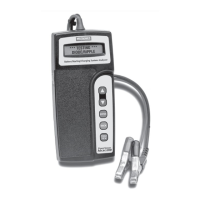• 8 •
Note: Some 8 cylinder vehicles and older vehicles idle at a high level
after starting. This can allow the analyzer to detect a rev without any
action being taken. If this occurs, continue on with the test process. The
final test results will not be affected.
Step 3: Testing at idle
The Micro500 will analyze the charging system output at idle for compari-
son to other readings.
Step 4: Diode/Ripple test
The Micro500 will look for the amount of ripple from the charging system
to the battery. Excessive ripple usually means one or more diodes have
failed in the alternator or there is stator damage.
Step 5: Testing with accessory loads
The Micro500 will prompt you to turn on accessory loads, then test at
idle, then prompt you to rev the engine for 5 seconds.
The analyzer will determine if the charging system is able to provide
sufficient current for the demands of the vehicle’s electrical system.
Note: When asked to turn on the accessory loads, turn on the blower to
high (heat), high-beam headlights, and rear defogger.
Do not use cyclical loads such as air conditioning or windshield
wipers.
Step 6: Analyzing Data
The Micro 500 will analyze all readings to provide the results of the
charging system test.
CHARGING SYSTEM TEST RESULTS
At the conclusion of the test, the Micro500 will output one of the following
results and, the idle voltage and load voltage:
CHARGING SYSTEM NORMAL\DIODE RIPPLE NORMAL
No problem detected. The system is showing normal output from the
alternator.
CHARGING SYSTEM PROBLEM
A problem was detected in the charging system. The potential cause of
the problems are listed below:

